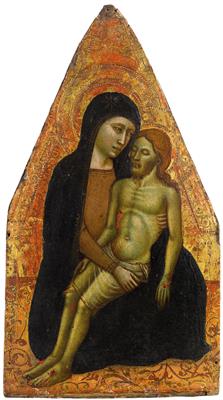Cecco di Pietro

(documented in Pisa from 1364 to 1399 – died before 1402)
Pietà,
tempera on panel, gold ground, 34.8 x 19 cm, shaped top, unframed
Provenance:
European Private Collection
The present painting is an early work by Cecco di Pietro and was, based on its format, probably the upper end of a polyptych.
The panel has been dated to the Pisan artist’s early period by Carlo Volpi. It is stylistically very close to the panel, The Exequies of Saint Bernard (Musée des Beaux-Arts, Dijon). The painting also displays the clear influence of the figural modelling that is typical of the Pisan School, such as Cecco’s Pietà e Santi from 1377 and the central predella panel of the crucifixion polyptych (both Museo Nazionale di San Martino, Pisa) of 1386.
The stylistic comparison enables the present panel to also be dated to about 1386. Worth mentioning are also the similarities to the divided 1386 polyptych, the central panel of which, depicting a Madonna and Child, is currently preserved at the Portland Art Museum, whilst its four wings are at the Musée du Petit Palais in Avignon. In addition, at least three more panels with an image of the Madonna by Cecco di Pietro are known, one formerly in the Salocchi Collection, Florence, a second in the Uffizi and a third in the Copenhagen Museum, the upper end of which could be precisely the present panel, and a fourth panel, depicting the Birth of Mary, preserved in the Church of San Pietro in Vinculis in Pisa until the 18th century and dated to 1386, which iconographically matches the present painting very well.
Cecco di Pietro is first mentioned in documents from 1371/72, when he collaborated in the restoration of Taddeo Gaddi’s Story of Jacob in the Campo Santo under Francesco Neri da Volterra. In 1402 he is mentioned as having already died. His artistic output probably reached its zenith in the 1370s and 1380s. In 1395 he painted a chapel in San Martino in Pisa, which constitutes the last certain documentation of his activity. In 1395 – as is documented in biographical notes concerning his patron – he was commissioned to paint what would become his masterpiece, the Polyptych in Agnano (currently Cassa di Risparmio, Pisa). His style oscillates between that of his teacher, Francesco Neri, the local trends of Traini, and the Sienese taste influenced by Simone Martini and Lippo Memmi.
21.10.2014 - 18:00
- Dosažená cena: **
-
EUR 52.500,-
- Odhadní cena:
-
EUR 10.000,- do EUR 15.000,-
Cecco di Pietro
(documented in Pisa from 1364 to 1399 – died before 1402)
Pietà,
tempera on panel, gold ground, 34.8 x 19 cm, shaped top, unframed
Provenance:
European Private Collection
The present painting is an early work by Cecco di Pietro and was, based on its format, probably the upper end of a polyptych.
The panel has been dated to the Pisan artist’s early period by Carlo Volpi. It is stylistically very close to the panel, The Exequies of Saint Bernard (Musée des Beaux-Arts, Dijon). The painting also displays the clear influence of the figural modelling that is typical of the Pisan School, such as Cecco’s Pietà e Santi from 1377 and the central predella panel of the crucifixion polyptych (both Museo Nazionale di San Martino, Pisa) of 1386.
The stylistic comparison enables the present panel to also be dated to about 1386. Worth mentioning are also the similarities to the divided 1386 polyptych, the central panel of which, depicting a Madonna and Child, is currently preserved at the Portland Art Museum, whilst its four wings are at the Musée du Petit Palais in Avignon. In addition, at least three more panels with an image of the Madonna by Cecco di Pietro are known, one formerly in the Salocchi Collection, Florence, a second in the Uffizi and a third in the Copenhagen Museum, the upper end of which could be precisely the present panel, and a fourth panel, depicting the Birth of Mary, preserved in the Church of San Pietro in Vinculis in Pisa until the 18th century and dated to 1386, which iconographically matches the present painting very well.
Cecco di Pietro is first mentioned in documents from 1371/72, when he collaborated in the restoration of Taddeo Gaddi’s Story of Jacob in the Campo Santo under Francesco Neri da Volterra. In 1402 he is mentioned as having already died. His artistic output probably reached its zenith in the 1370s and 1380s. In 1395 he painted a chapel in San Martino in Pisa, which constitutes the last certain documentation of his activity. In 1395 – as is documented in biographical notes concerning his patron – he was commissioned to paint what would become his masterpiece, the Polyptych in Agnano (currently Cassa di Risparmio, Pisa). His style oscillates between that of his teacher, Francesco Neri, the local trends of Traini, and the Sienese taste influenced by Simone Martini and Lippo Memmi.
|
Horká linka kupujících
Po-Pá: 10.00 - 17.00
old.masters@dorotheum.at +43 1 515 60 403 |
| Aukce: | Obrazy starých mistrů |
| Typ aukce: | Salónní aukce |
| Datum: | 21.10.2014 - 18:00 |
| Místo konání aukce: | Wien | Palais Dorotheum |
| Prohlídka: | 11.10. - 21.10.2014 |
** Kupní cena vč. poplatku kupujícího a DPH
Není již možné podávat příkazy ke koupi přes internet. Aukce se právě připravuje resp. byla již uskutečněna.
